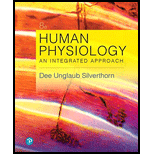
Pearson eText Human Physiology: An Integrated Approach -- Instant Access (Pearson+)
8th Edition
ISBN: 9780135212905
Author: Dee Silverthorn
Publisher: PEARSON+
expand_more
expand_more
format_list_bulleted
Concept explainers
Question
Chapter 2, Problem 6RQ
Summary Introduction
To determine: The two elements that are responsible for providing polarity to a given molecule.
Introduction: The polar molecules have positive and negative ends that are formed when the electron pairs with their covalent bonds and are unevenly shared between the linked atoms. When the electrons are shared unequally, the atom with the stronger attraction for electron develops a slightly negative charge, and the atom with the weaker attraction for electrons develops a slightly positive charge.
Expert Solution & Answer
Want to see the full answer?
Check out a sample textbook solution
Students have asked these similar questions
Is protein a tertiary structure?
Identify the chirality center (sometimes called chiral atom) in each molecule. If the molecule does not contain a chirality center, select none
What is difference between a nucleoside and a nucleotide ?
Chapter 2 Solutions
Pearson eText Human Physiology: An Integrated Approach -- Instant Access (Pearson+)
Ch. 2.1 - List three major essential elements found in the...Ch. 2.1 - What is the general formula of a carbohydrate?Ch. 2.1 - Prob. 3CCCh. 2.1 - Prob. 4CCCh. 2.1 - Prob. 5CCCh. 2.1 - Prob. 6CCCh. 2.2 - Which dissolve more easily in water, polar...Ch. 2.2 - Prob. 8CCCh. 2.2 - Why does table salt (NaCl) dissolve in water?Ch. 2.2 - Prob. 10CC
Ch. 2.2 - pH is an expression of the concentration of what...Ch. 2.2 - Prob. 12CCCh. 2.3 - Prob. 13CCCh. 2.3 - Prob. 14CCCh. 2.3 - Match each chemical to its action(s).Ch. 2.3 - What happens to the rate of an enzymatic reaction...Ch. 2.3 - What happens to the rate of an enzymatic reaction...Ch. 2 - Prob. 1CRQCh. 2 - Prob. 2CRQCh. 2 - Prob. 3CRQCh. 2 - Prob. 4CRQCh. 2 - Name the element associated with each of these...Ch. 2 - Write the one- or two-letter symbol for each of...Ch. 2 - Prob. 7CRQCh. 2 - Prob. 8CRQCh. 2 - H+ is also called a proton. Why is it given that...Ch. 2 - Prob. 10CRQCh. 2 - Prob. 11CRQCh. 2 - Prob. 12CRQCh. 2 - Prob. 13CRQCh. 2 - Prob. 14CRQCh. 2 - Prob. 15CRQCh. 2 - What aspect of protein structure allows proteins...Ch. 2 - Prob. 17CRQCh. 2 - List the three components of a nucleotide.Ch. 2 - Compare the structure of DNA with that of RNA.Ch. 2 - Distinguish between purines and pyrimidines.Ch. 2 - Prob. 1RQCh. 2 - Prob. 2RQCh. 2 - Prob. 3RQCh. 2 - Prob. 4RQCh. 2 - Fill in the blanks with the correct bond type. In...Ch. 2 - Prob. 6RQCh. 2 - Prob. 7RQCh. 2 - Prob. 8RQCh. 2 - Prob. 9RQCh. 2 - Prob. 10RQCh. 2 - Prob. 11RQCh. 2 - A molecule that binds to another molecule is...Ch. 2 - Prob. 13RQCh. 2 - Prob. 14RQCh. 2 - Prob. 15RQCh. 2 - Prob. 16RQCh. 2 - A solution in which [H+] = 103 M is...Ch. 2 - Prob. 18RQCh. 2 - Prob. 19RQCh. 2 - Prob. 20RQCh. 2 - Prob. 21RQCh. 2 - Prob. 22RQCh. 2 - Prob. 23RQCh. 2 - Prob. 24RQCh. 2 - Prob. 25RQCh. 2 - The graph shown below represents the binding of...
Knowledge Booster
Learn more about
Need a deep-dive on the concept behind this application? Look no further. Learn more about this topic, biology and related others by exploring similar questions and additional content below.Similar questions
- Which of the following structures represent the same stereoisomer? a) only I and II b)only II and III c) I,II, and III d) only I and IIIarrow_forwardWhy is polarity a key connection between the structure of a molecule and its properties?arrow_forwardIf you are given the structure of a molecule, explain how you would determine if it’s chiral or achiralarrow_forward
- Select three components that would make up a nucleotide and would the nucleotide be part of DNA or RNA? Would it contain purine or a pyrimidine?arrow_forwardEstimate the molecular weight of a B-a-B supersecondary element that is 3 nm high? Note: This is the complete question if you don't know the solution please leave it for someone.arrow_forwardExplain how the primary structure of a polypeptide influences its secondary and tertiary structures.arrow_forward
- What are the names of the seven functional groups found in organic molecules? Underline the two that can act as an acid. Make the single group that acts as a base in bold lettering.arrow_forwardIdentify the following macromolecules as either a carbohydrate, lipid, protein, or nucleic acid.arrow_forwardDefine monomerarrow_forward
arrow_back_ios
SEE MORE QUESTIONS
arrow_forward_ios
Recommended textbooks for you
 Biology (MindTap Course List)BiologyISBN:9781337392938Author:Eldra Solomon, Charles Martin, Diana W. Martin, Linda R. BergPublisher:Cengage Learning
Biology (MindTap Course List)BiologyISBN:9781337392938Author:Eldra Solomon, Charles Martin, Diana W. Martin, Linda R. BergPublisher:Cengage Learning

Biology (MindTap Course List)
Biology
ISBN:9781337392938
Author:Eldra Solomon, Charles Martin, Diana W. Martin, Linda R. Berg
Publisher:Cengage Learning
Macromolecules | Classes and Functions; Author: 2 Minute Classroom;https://www.youtube.com/watch?v=V5hhrDFo8Vk;License: Standard youtube license